Abstract
Interest in water mist fire suppression has increased within the fire protection industry due to its ability to control the spread and development of fire without using environmentally damaging agents. Water mist fire suppression has been used for many years in various applications such as machinery spaces, combustion turbine enclosures, and onboard passenger sea vessels. Now there is a demand to use this firefighting method to protect other fire risks such as cooking areas, commercial buildings, residential buildings, electrical equipment, road tunnels, bushfire (wildland fire) protection, and nuclear power generation facilities. To support this industry demand, this review covers the fundamentals of water mist, its suppression mechanisms, areas of application, existing research and development, and the codes and standards related to design. This comprehensive review provides a clear history of water mist suppression. It is able to identify the issues and challenges related to the technology to help pave the way for future research and development that will improve these systems to a level so that they are suitable for these new applications and meet the industry demand for nontoxic fire suppression systems.
1. Introduction
In the firefighting and fire safety industries, halon was widely utilised as a fire control agent. However, such substances are not only hazardous to people but also damage the ozone layer [1,2]. As a result, nations all over the world have prohibited their manufacturing and usage since the end of the twentieth century [3]. In order to identify a substitute for halon, effective and environmentally acceptable fire extinguishing technologies have become a research hotspot in the field of fire safety during the last 20 years [3]. There is a growing interest in using CO2, inert gas, and water sprinklers as replacements. However, despite all efforts to substitute with alternative clean agents, the goal remains challenging due to several constraints. For example, using CO2 to control fire can displace oxygen in the air and may be hazardous to human health [4]. Sprinklers are the most widely utilised fire suppression system in many applications, such as buildings, owing to their demonstrated efficacy in minimising the intensity of fire and fire spread beyond the fire origin. However, there are worries that sprinkler systems might cause postfire water damage to structures and equipment [5]. Furthermore, this suppression system has disadvantages in some locations where water supplies are restricted and suppression is required in confined spaces, such as ship fires and spaceship fires, among others [3].
Water mist fire suppression technology has been developed in recent years and is regarded as a prospective replacement agent due to its qualities of speedy fire extinguishment, minimal environmental concerns, minimal water usage, and reduced water damage [1,6,7]. In the 1940s, the National Fire Protection Association (NFPA) Technical Committee designed water mist systems for specialised purposes, such as passenger ferries [8]. In the 1980s, the Manchester Air Accident and an International Maritime Organisation (IMO) rule requiring the installation of fire sprinklers rekindled interest in employing water mist systems to extend the tenability of space for the safe evacuation of passengers through heat management and fire suppression [9]. Following the fire that killed 159 passengers on the MS Scandinavian Star ferry on a route from Norway to Denmark on 7 April 1990, the water mist fire suppression system gained prominence in the maritime and insurance industries [10]. Since then, the application areas for water mist systems have expanded at an exponential rate. The technology now has a wide range of applications in preventing and dealing with historical building fires [7], tunnel fires [11], ship fires [12], nuclear power plant fires [13], and explosion fires [9,14,15,16,17].
Water in the form of a mist has been found to be an efficient extinguishing agent, and NFPA defines water mist as a water spray in which 99% of the water is in droplets with diameters (Dv99) smaller than 1000 microns [8]. The development of fine water mist systems offers a new water-based suppression alternative for many potential applications. Figure 1 shows the typical fire water mist suppression system arrangements. Since the fire-extinguishing mechanisms behind the water mist system are different from standard sprinkler systems, researchers have focused their attention on investigating those mechanisms required to suppress fire successfully [18].

Figure 1.
Water mist fire suppression general arrangement.
Various research studies have been utilised to experimentally and numerically examine the effectiveness of water mist systems [2,3]. In particular, several researchers have examined the dynamics of the water mist system and the effects of different fire compartment factors on the performance of water mist fire suppression [17,19,20]. To identify the future development and direction of water mist fire extinguishing technology, as well as expand its area of application, this paper summarises the latest research progress of extinguishing mechanisms of water mist in fire suppression. It also discusses the influence of the spray dynamics of water mist, such as water mist additives, operating pressure, water droplet size, flow rate, nozzle K-factor, spray momentum, and spray angle on the effectiveness of water mist as a fire extinguishing agent. The effects of ceiling height, ventilation, and different dynamic mixing situations in fire compartments on the fire suppression process of water mist are also discussed in this review. This review discusses how this existing knowledge related to water mist system can potentially be used in new and emerging industries and protect people and property from their associated fire risks. The study also extends to existing design codes of water mist systems for different countries and highlights how legislation and system approvals may be restricting potential applications for this firefighting method. Various challenges are highlighted using current research data, and finally, the paper concludes with various suggestions about the observed challenges and issues.
2. Water Mist Fire Systems
2.1. Methods of Generating Water Mist
Water mist is a water spray for which 90% of the flow-weighted cumulative volumetric distribution of water droplets (DV0.90) is less than 1000 µm. This value is found at the minimum design operating pressure and is measured in a plane 1 m from the nozzle. NFPA 750 [8] defines three mist classifications within this 1000 µm window, which are categorised as Class 1 (DV0.90 ≤ 200 µm), Class 2 (200 µm< DV0.90 ≤ 400 µm), and Class 3 (DV0.90 > 400 µm). Three different operating pressures are suggested by NFPA [8] to create these droplet sizes of water mist. The pressure ranges are low pressure (pressure ≤ 12.1 bar), intermediate pressure (12.1 bar < pressure < 34.5 bar), and high pressure (pressure ≥ 34.5 bar). Droplet size also depends on the discharge nozzle, which significantly influences the production of the water mist spray. Three different types of nozzles, impingement, pressure jet, and twin-fluid nozzles, are mainly used to create water mist spray, as shown in Figure 2.
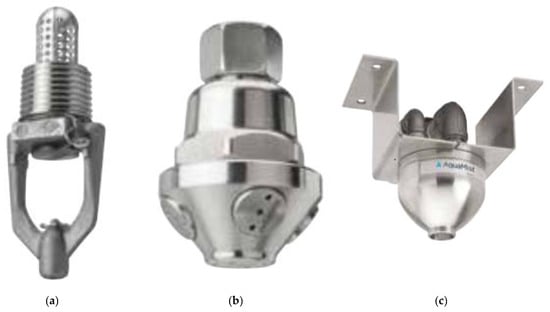
Figure 2.
Types of nozzles used to create water mist in water mist systems. (a) Impingement nozzle [21]; (b) Pressure jet nozzle [21]; (c) Twin-fluid water nozzle [21].
2.1.1. Impingement Nozzles
Impingement nozzles, as shown in Figure 2a, are common in water-based fire suppression, and the operating principle is typical of such a fire sprinkler. A large diameter orifice allows water to flow from the nozzle and impact with a deflector that impinges the flow. The deflector is designed to break up the high-velocity flow and create a flow of smaller water droplets. Impingement has been used to generate coarser mists of Class 2 and Class 3 to be used on low- and intermediate-pressure systems.
2.1.2. Pressure Jet Nozzle
Pressure jet nozzles consist of smaller-diameter orifices or swirl chambers, as shown in Figure 2b. A high-velocity jet of water flowing through the nozzle creates a thin jet of water that become unstable with discharge into the atmosphere and disintegrates into fine droplets. Pressure jet nozzles are used across low-, intermediate-, and high-pressure systems and can create Class 1-type mists below 200 µm. Multi-nozzle heads are common for this type of nozzle to increase the spray cone angle.
2.1.3. Twin-fluid Nozzle
Twin-fluid nozzles, as shown in Figure 2c, are designed to operate with water and compressed gas (typically air or nitrogen). This design has two inlets into the nozzle chamber where the high-pressure gas atomises the water before discharging into the atmosphere, with further agitation causing water droplets to break down further. The water and gas inlet lines operate at different pressures; typically, both are below 12.0 bar and within the low-pressure range. These systems can produce a finer water mist of Class 1 and Class 2 sprays. The use of nitrogen in a twin-fluid system can also add additional fire suppression performance by improving the primary suppression mechanisms of water mist systems.
2.2. Fire Control and Suppression Mechanisms
It is widely agreed that fire can take many forms involving chemical reactions between combustible species and oxygen. A common simplification often describes the combustion process of fire using the fire triangle (or tetrahedron), where the inputs are fuel, oxygen, and heat/ignition (and chemical reaction). Most fires involve combustible solids, although liquid and gaseous fuels are found in many industry sectors [22]. When in the appropriate conditions, these fuels will react with the oxygen in the air, generating combustion products and releasing heat. This heat acts as a continuous ignition source for surrounding fuels, which maintains the continued combustion process of the burning fire. Water mist fire suppression mechanisms work to inhibit this burning process using three main mechanisms (heat extraction, the displacement of oxygen, and radiation attenuation) categorised into primary and secondary mechanisms (Figure 3).
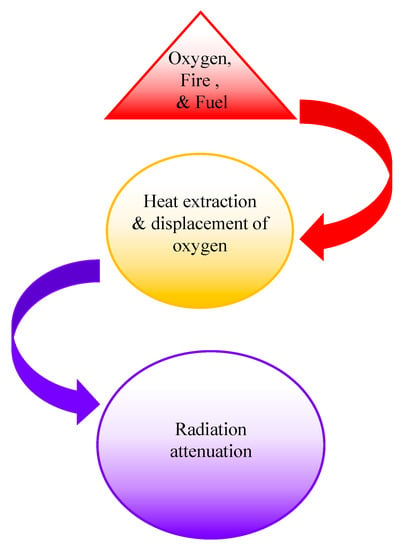
Figure 3.
Fire suppression mechanism of water mist.
These suppression mechanisms work by removing two sides of the fire triangle by reducing the oxygen in the atmosphere and reducing the heat output that feeds the continuous ignition of additional fuel sources. In the primary mechanism, heat is extracted to cool the fire plume and wet/cool the fuel surface, and then oxygen is displaced and diluted by blocking it from the fuel sources. In this stage, the water mist expands faster due to the faster vaporisation and cools the hot gases in the fire area. In the secondary mechanism, expanded water mists block the radiant heat transfer to the surrounding fuel surfaces.
2.2.1. Heat Extractions
Water is widely used as an extinguishing medium for fire because of its ability to cool flames, burning fuel, and the surface of surrounding fuels not yet involved in the fire. Water can absorb a significant amount of heat due to a high heat capacity of approximately 4182 J/kg °C and high latent vaporisation heat of 2260 kJ/kg [23]. A flame will be extinguished if its temperature is reduced below its critical temperature. This critical temperature can be determined using Equation (1) [24].
where is critical flame temperature (°C) below which the flame will extinguish, is theoretical flame temperature (°C) assuming no heat losses to the surface, is the surface temperature of the fuel–fire point temperature (°C), is the mass fraction of oxygen in the atmosphere, is the mass fraction of fuel vapour immediately above the liquid surface, and is the stoichiometric ratio (mass of O2 required to burn a unit mass of fuel).
Water has also the ability to extinguish fire by cooling the burning fuel below its fire point by removing heat from the fuel surface (Figure 4). Fuel cooling by water mist is primarily due to heat removal during water conversion to steam. This heat removal rate per unit area can be estimated using Equation (2) [6].
where is the heat removal rate per unit area (kJ/m2.s), is convective heat transferred from flames per unit mass of fuel (kJ/kg), is the heat required to produce a unit mass of vapour (kJ/kg), is the burning rate per unit area (kg/m2.s), is heat transferred to the fuel surface (kJ/m2.s), and is heat lost from the surface (kJ/m2.s) not included in .

Figure 4.
Heat extraction and water displacement of water mist system.
When the water is converted to steam and extracts the heat, it is also contributing to the displacement of oxygen within the combustion zone. The critical extinguishment concentration of water mist surrounding a diffusion flame ranges from 100 to 200 g/m3.
2.2.2. Oxygen Displacement
Reducing oxygen from a fire has long been used as a reliable fire suppression method (Figure 4). When a water mist system is discharged locally onto a fire or within a fire compartment, the small water droplets are heated and transformed into steam. When this vaporisation of water occurs within the flame zone, the volumetric expansion can disrupt the entrainment of oxygen into the flame and significantly reduces the oxygen concentration in a compartment [25]. Water mist systems achieve oxygen displacement by producing excessive amounts of steam. The water mist droplets tend to be evaporated before reaching the fire flame, and the evaporated steam causes O2 displacement and contributes to the suppression of the fire [19]. When the water spray penetrates the fire plume, the vaporising water expands to 1600 times its liquid volume [6,26]. This volumetric expansion distributes the entrainment of oxygen into the flame and dilutes the fuel vapour available for combustion. This contributes to the suppression and extinguishment of the flame by diluting the vapour below its fuel–oxygen mixture flammable limit for the given fuel source (removing the chemical reaction required).
The impact of oxygen dilution by water mist is dependent on the properties of the fuel. The minimum amount of oxygen concentration required to support combustion varies depending on the fuel source. Oxygen typically makes up 21% of the air in naturally low atmospheric conditions and is the baseline oxygen concentration for a typical fire. Hurley [25] explained that smouldering and flaming fires need to be below 10% and 16% O2 concentration, respectively, to be smothered. Xin and Khan [27] investigated the limiting oxygen concentration (LOC) in which a fire will reach extinction. Table 1 shows the LOC percentage of various liquid and solid fuels, which varies from 11% to 15% O2 concentration. Mawhinney et al. [28] and Liu et al. [29] explained that the hot layer of gases in a fire compartment is rapidly cooled by its first contact with water mist and forced down by the spray to the seat of the fire. This is known as turbulent mixing and contributes to extinguishment through oxygen depletion. This increase in water mist particles surrounding the flame also inhibits the spread of fire through the attenuation of radiation.

Table 1.
Limiting oxygen concentration at fire extinction [27].
2.2.3. Radiation Attenuation
Water mist can prevent fire spread by acting as a thermal barrier to inhibit heating by radiation from the burning fuel to nonburning surfaces surrounding the fire (Figure 5). A substantial amount of heat released from flames is transmitted by radiation during typical fire scenarios. This is a form of energy travelling as electromagnetic waves through a material or space [22]. During a fire, surrounding materials absorb, reflect, or transmit this energy, which increases the temperature and initiates pyrolysis. Kashiwagi [30] described the pyrolysis mechanism of a solid material that causes fuel vapour to be released. The fire spreads as these volatile vapours are ignited by travelling embers or from direct flame contact. Balner [31] described how water droplets prevent the transmission of radiant heat due to the absorption and scattering of thermal radiation. This is known as attenuation (Planck mean absorption coefficient) and is described as the blocking effect [22]. This absorption coefficient of materials has a direct relation to its ability to absorb radiation and heat energy. Figure 6 shows the high absorption coefficient of water (H2O) compared with other gases at various temperatures [25].

Figure 5.
Attenuation of thermal radiation by a water mist system.
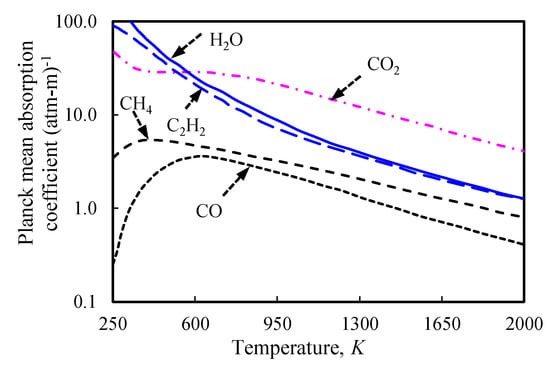
Figure 6.
Planck mean absorption coefficient for various gases [25].
To prevent the heating and ignition of a nonburning surface fuel by radiation, water droplets also wet the surface. The minimum water flow required to prevent the ignition of these surfaces can be calculated using Equation (3) [25].
where is the minimum water flow rate (m3/s), is the fuel surface area (m2), is emissivity of the radiator, is the Stefan–Boltzmann constant (5.67 × 10−8 W/m2K4), is the view factor of the fuel bed, is the mean absolute temperature of the radiation source (K), is the mean absolute temperature of the surface (K), is the critical radiation intensity required for piloted ignition (kJ/kg), and is the heat vaporisation of water (kJ/kg).
The performance of a water mist system in a fire depends on its ability to achieve these three suppression mechanisms: (1) removing heat from the gases, (2) the displacement of oxygen by water vapour, and (3) the attenuation of radiation by water droplets. Understanding these mechanisms has led to various water mist system applications for common and unique fire hazard types across multiple industries.
3. Applications of Water Mist Systems
Water mist systems have been proven to perform in many applications, such as enclosed compartments; open air; and large, well-ventilated spaces [25]. In addition, water mist systems are also used as a fire protection method in many applications for industrial facilities, commercial buildings, electrical equipment, residential buildings (including bushfire protection), transportation, tunnels, and explosion hazard mitigation (Figure 7).

Figure 7.
Common applications of water mist systems.
3.1. Machinery Spaces
In recent years, water mist has emerged as an alternative suppression medium over CO2 and halocarbon gaseous agents in machinery spaces for its ability to remove heat from hot surfaces without environmental impact. Machinery spaces such as large engine rooms on a ship or within a manufacturing process facility create flammable liquid hazards in the form of liquid fuel and lubricating and hydraulic oils. A ruptured hydraulic line can create fuel spray fires or liquid pool fires if the hot engine components ignite. There are many different test protocols established by IMO, Underwriters Laboratories (UL), and Factory Mutual (FM) related to machinery spaces for various fire scenarios that may occur in machinery spaces. These test fire scenarios are for various fire types, fire sizes, compartment obstructions, fuel types, ignition sources, compartment sizes, and ventilation conditions. The recent studies completed by Jeong et al. [28] and Choi et al. [32] applied water mist to engine diesel generators, shipboard engine rooms, and machinery spaces following IMO test protocols and found that water mist can effectively extinguish various fires, including spray fires, pool fires, and cascade fires that may occur in machinery spaces. A larger fire within the machinery space relative to the compartment size is easier to extinguish due to the larger amount of steam generated to displace the oxygen. According to these studies, using water mist to protect machinery spaces from fire is a preferable option. The quantity of water mist test protocols that are written specifically for machine space protection supports this use. The industrial environment is constantly changing as a result of new technology, so it is crucial that fire protection techniques such as water mist adapt as well to account for these new risks.
3.2. Power Generation Turbines
Turbine enclosures are seen as another type of machinery space, except the potential fire sources differ. The fire source in a turbine enclosure is mainly limited to the turbine itself and the associated fuel line. Water mist suppression is well suited for protecting turbine enclosures for its ability to extinguish fire rapidly and efficiently while producing minimal thermal shock and corrosion damage, post-fire clean-up requirements, and negative environmental impacts. A requirement of the FM Global Test Protocol 5560 approval for turbine protection is that the cooling of the turbine casing will not result in damage to the turbine blades. To overcome this, manufacturers have incorporated the cycling discharge method, which sprays momentarily on–off pulses to reduce the rapid cooling of the casing and still extinguish the fire within the required time [25]. Liu et al. [33] and Liu and Kim [6,34] established that cycling mist discharges into an enclosure resulted in a faster extinguishment and used less total water when compared with continuous applications. The increase in the compartment temperature during the off cycle of the water mist allowed for the evaporation of suspended droplets and the growing fire to further consume oxygen in the compartment. Once the water mist on cycle was reintroduced, it produced further cooling and turbulent mixing. The cycle is repeated until extinguishment is successfully achieved. This requirement makes turbines one of the more difficult fire hazards to protect effectively. Cycling discharge methods for turbines should be tested for other applications and fire risks to determine if the benefits can be applied to other fire risks. Because power generation is an expensive process with numerous potential safety hazards, fire protection methods are critical to turbine operators and insurers. Water mist has proven to be an effective method of fire suppression, but it will require ongoing research and development as new methods of power generation and storage are established. Water mist must be suitable for electrical equipment in order to be used in the power generation industry.
3.3. Electrical Equipment
Halon and CO2 gas agents are known methods for protecting electrical equipment from fires. There have been concerns regarding the use of water mist suppression as a replacement for halon and CO2 because of the electrical conductivity of the water causing damage or creating a risk of shock to personnel. Through various studies, water mist has since been proven to be a feasible protection method for electrical equipment in computer rooms, datacentres, and electrical switch gear cabinets [35,36,37]. Fires within these environments are typically slow-growing, where burning plastic-coated cables and circuit boards spread corrosive smoke. These studies showed that water mist could effectively extinguish fires without introducing any major electrical leakage across circuits or creating any critical damage to the equipment. The operation of the equipment remained unaffected during and after the studies. Water also proved to be superior to gas suppression for its ability to cool hot cable fires and avoid the reignition of plastics [38]. These findings show that water mist can be used safely in various applications, including control rooms for vital machinery or data storage facilities. Water mist suppression can do this as an environmentally safer alternative to previously used gases, which contribute to ozone depletion. Many industrial facilities place a high priority on the protection of this equipment to ensure fire safety in their normal operations. The ability to control fire with minimal water damage to the protected area also makes water mist an attractive alternative to fire sprinklers.
3.4. Transportation
Water mist is commonly used across many forms of transportation systems because it requires minimal water storage and is lightweight compared with other alternatives. Water mist fire suppression has been tested and approved for use on passenger ships, cargo ships, freight aircraft, military aircraft, road vehicles, and heavy machinery vehicles. In the 1980s, many lives were lost onboard during passenger ferry fires, leading to the International Maritime Organization (IMO) regulating sprinklers on all ships capable of carrying 35 or more passengers [25]. Due to the complexity of adding sprinklers to existing ships not designed for the weight and additional space required for the system, there was a large push in research and development to find a system equivalent to sprinklers that could be fitted. Testing showed that the water mist system was more effective at extinguishing shielded fire when compared with conventional sprinklers and provided equivalent or better protection for small cabins [39]. The system should be designed specifically for each fire compartment and risk. Most maritime authorities worldwide will accept a cabin water mist system that meets the IMO test protocol.
The cargo area of ships presents a large fire hazard due to the dense fuel loads within the compartment. Large-scale tests conducted by the Technical Research Institute of Sweden found that roll-on–roll-off (ro-ro) cargo decks on ships could be protected using a water mist system, which provided an increase in flow rate when compared with traditional water spray systems [40]. The system was effective for direct applications, though the system could not extinguish shielded fires when covered by shelving.
Water mist has also been tested for cargo fires on large aircraft. Full-scale testing was conducted by the Federal Aviation Administration [41,42] to determine if water mist is an alternative to halon on aircraft cargo fires. These fires are typically deep-seated, involving a wide variety of fuels. The tests showed that for water mist to be effective it required a high-pressure discharge where it could control a fire for up to 90 min. The performance objective for aircraft cargo fires is to control the fire for 180 min to allow for a safe landing before evacuation [38]. Water mist has not yet been proven to be an equivalent alternative to halon fire suppression on cargo or military aircraft, and, therefore, there will be an exception for the use of this ozone-depleting gas in the aviation industry until an effective substitute is found that meets the lightweight suppression requirements for aircraft safety.
The performance requirements for ground transportation are less onerous, and water mist has been used as a protection method for transport trucks, military combat vehicles, and heavy industrial machinery such as mining trucks and equipment [38]. Water mist is used to suppress diesel vehicle engine fires in a similar way as it is to suppress large industrial engine room fires. This research has significance because every type of transportation vehicle requires low-profile fire protection equipment. The equipment cannot significantly reduce the amount of space that can be used for cargo or passengers and must be installed within aircraft, sea vessels, and road vehicles without adding extra weight that reduces travel distances and increases fuel consumption. Comparing water mist with other fire suppression techniques, such as sprinklers, it can be said that water mist belongs to the category of low-profile equipment. The world is moving towards more freight due to import trade and online shopping, which requires support from the fire protection sector in the form of ongoing research and development. In big cities with a growing population and commuter problems, transportation safety is a crucial issue.
Burn-over protection for firefighting vehicles used externally for bushfire (wildland fire) purposes in Australia has recently incorporated cabin and vehicle spray systems for the protection of occupants and could have wider applications using mist systems (AFAC, 2021). The role of misting systems would need to be assessed in the context of wind conditions before using finer mists than those applied at present.
3.5. Road and Rail Tunnels
Water-based fire protection was originally discredited for use in tunnels until a series of serious highway and rail tunnel fires occurred between 1995 and 2005 [25]. This led to the development of water mist systems for road tunnels being one of the most active research areas. Fire tests carried out in Switzerland [43] involved burning passenger cars arranged to simulate an accident involving three (03) vehicles in a tunnel. The activation of the water mist system was able to control the burning of the three (03) vehicles and keep the fire from spreading to the adjacent vehicle until the fire consumed all the fuels available within the three (03) controlled cars. As fuel tanks were ruptured, the water mist was able to easily extinguish the burning liquid fuel and cool it as it spread across the roadways. Tunnel safety researchers claim that water mist also improves visibility within tunnels during fire scenarios and assists in safe evacuation [15,43]. The research is in furtherance of using water mist in road tunnels. As tunnel construction varies, it is crucial that it be used in each individual case. To prove its effectiveness in conjunction with other protection systems, such as extraction exhaust fans or fire detection techniques, research and testing need to be conducted. Current research on fire protection in tunnels is intense, and more studies on the use of water mist should be conducted.
3.6. Nuclear Power Generation
Fire protection systems for nuclear powerplants are designed with the concept of defence-in-depth. This involves fire prevention, rapid detection and suppression, and safe shutdown capability [40]. Ha et al. explained that water mist fire extinguishing systems are a very good candidate for protecting safety shutdown equipment in fire compartments because the application of water spray needs to be restricted [44]. Several recent studies were conducted to apply water mist systems to nuclear powerplants, typically in emergency diesel generator rooms or the electrical rooms of a reactor [9,13,45]. The findings were similar to existing research on water mist suppression in power generation and industrial occupancies. Nuclear power is often considered when discussing alternative energy generation methods. It is critical that fire suppression is performed safely if nuclear power is to be considered for use. Water mist fire protection should be investigated if it can improve nuclear powerplant safety. It may be useful for other aspects of nuclear power safety.
3.7. Explosion Hazard Mitigation
Hazardous explosion areas created by airborne gases can become extremely dangerous if ignited [17]. Water mist discharge into an unconfined environment with high momentum can entrain air into a gas cloud and dilute it below its lower flammable limit, reducing the potential for ignition and explosion. If ignited, during the explosive ignition of a gas cloud with a high flame speed and a shockwave, the spray/mist can reduce deflagration pressure and possibly extinguish the flame. The shockwave breaks up the droplets into a micro-mist that can quickly evaporate to absorb a significant fraction of the combustion energy released during the deflagration. To be effective, water mist must be produced at a smaller droplet size of around 1 µm, which is smaller than what is seen to be achievable for the existing water mist products for fire suppression that have been reviewed [46,47]. During this literature review, there was little research found on this topic. It appears to be an intriguing application that should be further developed.
3.8. Cooking Areas
Commercial and industrial cooking oil or fat fryers are difficult to protect from fire due to their high temperatures and ability to reignite easily [45]. In order to extinguish the fire, the entire surface of the oil must be suppressed simultaneously with the rapid cooling of the oil to prevent reignition [45]. Due to the chemical additives consistent in most fire suppression systems not being appropriate for the food production industry, there are limited options for protection. A common method is carbon dioxide (CO2), which can extinguish flames across the oil surface but is not able to cool the oil sufficiently and prevent reignition. Water mist has demonstrated good fire extinguishing and oil cooling capabilities for these fires [6,46,47,48]. Specifically, research by Liu et el. in 2006 [45] found that water mist effectively extinguished a large industrial oil fire and cooled the hot oil to prevent it from reigniting regardless of the oil depth. According to our literature review, water mist for oil fat fryers appears to have a significant advantage over alternative methods (such as foams). It is clearly a strong option because there are minimal methods for suppression that are acceptable for food processing. More food processing facilities are being built in metropolitan areas to allow for quick delivery to consumers, as the popularity of mass production of “ready-to-eat meals” has grown in recent years. Large fryer converters require fire protection in these facilities. Water mist should be researched further to see if it can be used on these conveyor-type fryers to protect the equipment and the people working around them. The primary motivation for fire protection is to protect people, so it is crucial to investigate the use of water mist in commercial structures as well.
3.9. Commercial Buildings
Water mist systems have been developed and used in commercial buildings, with FM Global and Underwriters Laboratories (UL) having test protocols for Light Hazard and Ordinary Hazard I and II, which are commonly protected by sprinkler systems. A water mist suppression system’s ability to suppress a fire and maintain minimal water damage to the protected area makes it an attractive option for protecting areas such as libraries, archives, heritage buildings, and museums [21,46,49,50]. Milke and Gerschefski [51] completed fire testing for library settings with shelving-type storage and book vaults for sensitive archives. A total compartment application was able to control the fire damage to the documents and extinguish shielded fires using 30% of the amount of water compared with a traditional sprinkler system. No damage occurred due to water, and only a minor amount of discolouration of documents was observed from smoke if stored closest to the shelf flue near the fire. It was noted that the water mist could not control the fire without discharging within 100 s of ignition. Sprinklers have been proven to be a reliable fire protection strategy in commercial structures. Before the industry switches from using standard sprinklers, the advantages of water mist systems over sprinklers would need to be further proved. Although more testing needs to be performed, water mist suppression has potential as an alternative.
3.10. Residential Buildings
Water mist can be suitable for residential occupancies in areas where water supplies are limited [52]. Fire testing on water mist in bedroom and kitchen fuel fires has found that water mist can control a fire with up to half the water required for a typical residential sprinkler [50,53,54]. The use of water mist as an alternative to sprinklers is limited by its reliability and cost [38]. Water mist systems, in combination with other life safety systems such as smoke detection, fire alarms, and passive systems, have been used in residential buildings [7]. These systems are used to mitigate the risk of life loss, protect areas where occupants are housed, increase tenable conditions where extended emergency exit travel distances are present, and protect high-value items or historic features of the building [54]. The use of these systems in residential buildings is limited by the information available for experts and approval authorities to apply and review. Aspects such as reliability, real fire historical data, and long-term maintenance requirements are largely unknown. There is a need for more research and development to enhance the understanding of these systems and how they can be used in all applications.
A further consideration is the protection of external building elements arising from bushfire events. For this application, consideration will need to be given to the “design bushfire” conditions, including ambient wind, when considering droplet sizes. The location and design of nozzles may need to be further researched in the use of misting systems for “real-world” bushfire protection purposes.
4. Research and Development on Water Mist Systems
Water mist suppression research can be completed using various methods including real fire testing experiments and computational numerical modelling. The literature on water mist systems consists of various experiment methodologies, including small-scale and large-scale fire testing. Small-scale experiments are typically conducted using minimal resources. They can be run in a timely fashion and repeated easily to obtain fast results compared with large-scale experiments. A typical example relating to fire water mist experiments would a laboratory-controlled test using one spray nozzle to suppresses a small pool fire. Large-scale experiments can be very costly, require copious amounts of planning and coordination, and are typically difficult to repeat. For example, completing a fire suppression test inside an aircraft hangar or warehouse building using multiple water mist nozzles discharging at the same time. These are enclosure fire tests, which are also recommended by different standards [50,55] and can be used for commercial and residential buildings. The studies reviewed here have been a combination of small-scale and large-scale experiments. The studies found in the literature have identified that the primary design parameters of a water mist system are the spray dynamics of the discharge nozzle and the compartment in which the system is installed. The research findings in the reviewed literature have been summarised in Table 2 by categorising the key system parameters and are further discussed in this section.

Table 2.
Experimental and numerical research on water mist suppression.
4.1. Spray Characteristics
The ability of a water mist system to extinguish specific fire types is affected by water mist additives, nozzle discharge pressure, water droplet size, flow rate, nozzle K-factor, spray momentum, and spray angle.
4.1.1. Effect of Different Water Mist Additives
Additives alter the viscosity of the suppression agent and, ultimately, the spray pattern and suppression performance. Different additives have been tested with water mist to achieve different objectives [17]. Additives, such as aqueous film-forming foam (AFFF), showed improved effectiveness for hydrocarbon pool fires [48]. Additives can be used to avoid the freezing of storage water in colder climates and have been found to improve the effectiveness of systems [68,69,70]. Adding nitrogen and other inert gases to the water mist can increase firefighting capabilities, leading to the development of twin-fluid systems [71,72]. Cong and Liao [18] studied the effects of suppressing liquid pool fires (Figure 8) with three separate firefighting additives: sodium bicarbonate (NaHCO3), multi-component agent (MC), and aqueous film-forming foam (AFFF).
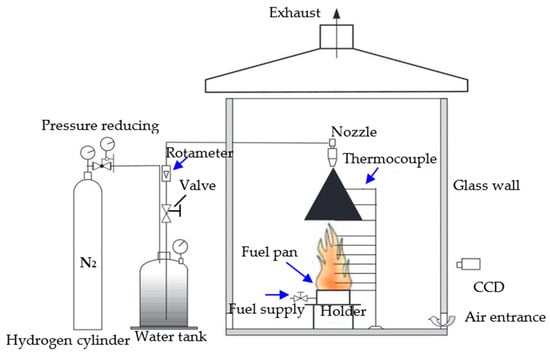
Figure 8.
Schematic of liquid pool fire with water mist system additives experimental apparatus [18].
Each additive proved a slight increase in the suppression time compared to pure water. Figure 9 (a-b) shows the greatest improvement due to liquid additives was the AFFF when suppressing hydrocarbon fires such as diesel from the foam, forming a thin layer of fluorinated surfactant on the liquid pool surface. Fluorinated firefighting foams, such as PFAS, being harmful to human health has led to their ban in most of the world. Foam and other additives are not commonly found in water mist suppression systems as they typically rely on water as the suppression medium, and its performance is controlled by other parameters such as the discharge pressure.
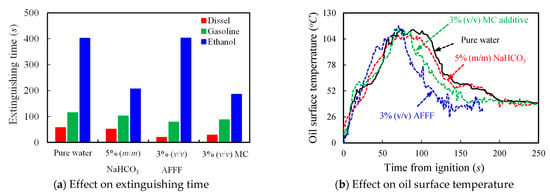
Figure 9.
Liquid pool fires suppressed by water mist with additives [18].
4.1.2. Effect of Different Operating Pressure
Yinshui et al. [20] and Lui et al. [29] each suggested that an increase in the operating discharge pressure of water mist nozzles contributes to the reduction in the fire extinguishment time. One key reason is that the higher operating pressure of the water mist system results in a stronger penetration into the flame zone. This contributes to the displacement of flammable mixtures in the flaming region for better suppression and reduces the risk of backdraft. The increase in pressure also results in a decrease in the water droplet size, as shown in Figure 10. It is known that a smaller water droplet size is one of the main drivers of water mist suppression performance.
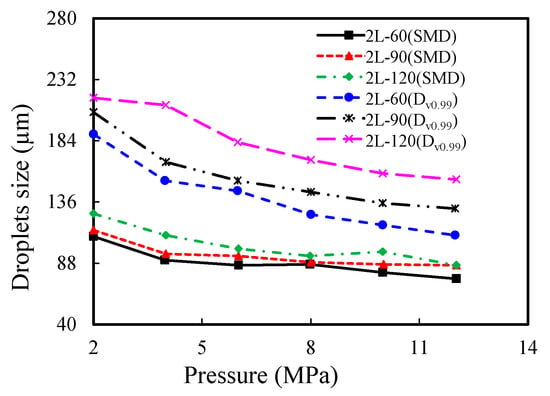
Figure 10.
Discharge pressure effect on water droplet size [20].
4.1.3. Effect of Different Water Droplet Sizes
The effect of water droplet sizes has been investigated by different researchers [19]. It has been noted that water droplet size is the main contributor to water mist system performance [19,45]. As droplet size is reduced below 1000 µm in diameter, it significantly improves extinguishment time, as shown in Figure 11.
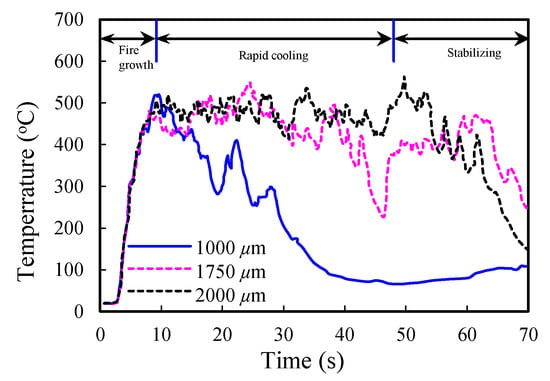
Figure 11.
Time histories of temperatures for various spray nozzle droplet sizes [29].
Rapid cooling is the result of a large amount of evaporation generating steam. This steam contributes to the O2 displacement and radiation attenuation, which are water mist suppression mechanisms. Figure 12a highlights the O2 concentration reduction when comparing water droplet diameters of 100 µm and 1000 µm. Ferng [19] observed the critical cooling time for different water mist droplet sizes between 100 µm and 1000 µm and found that performance was better at either end of the scale, as shown in Figure 12c. The effect of droplet size on the temperature reduction and extinguishment time is shown in Figure 12b and Figure 13 to provide examples from different experiments. For a smaller water droplet size closer to 100 µm, the fire is extinguished by rapid evaporation, causing O2 displacement and surrounding gas to cool. On the other end of the scale, closer to 1000 µm in regions II and III, the increased droplet size has greater mass and momentum to directly penetrate the flame region before evaporating. This phenomenon directly cools the burning fire surface and can provide a similar critical cooling time compared with other suppression mechanisms. This finding highlights that it is important for a water mist system to achieve an effective droplet diameter close to 100 µm. The cooling from the flame zone penetration achieved in regions II and III from the momentum can also be achieved for finer droplets if the spray velocity is increased, in other words, the nozzle’s flow rate.
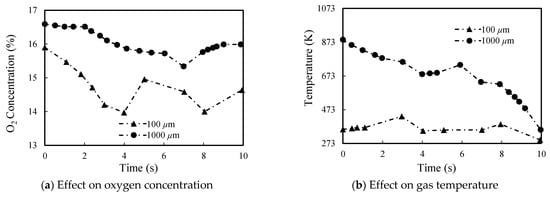
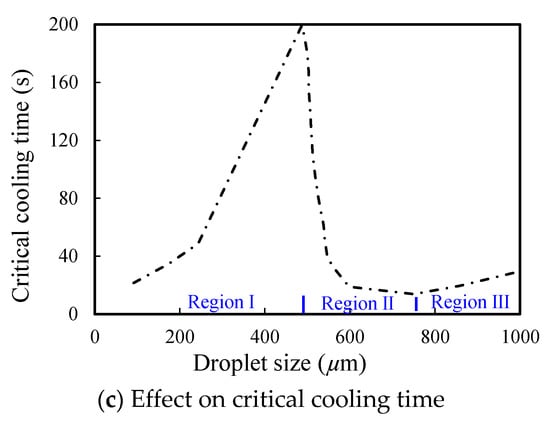
Figure 12.
Effect of various water mist droplet sizes [19].
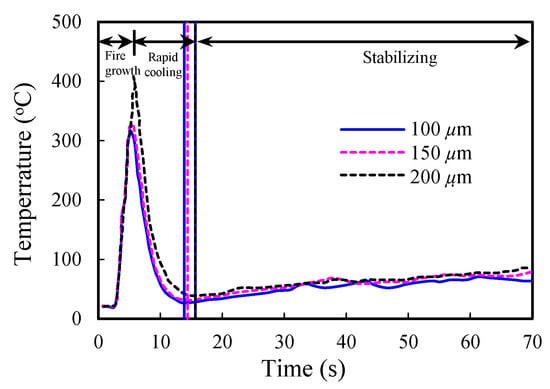
Figure 13.
Time histories of temperatures for various water mist droplet sizes [29].
The disadvantage of smaller droplet sizes is related to the effects of wind conditions, which can be an important consideration in the external environment or during turbulent, fire-generated wind conditions. The location and application rates may be related to specific components of a building, for example, outside of enclosed spaces.
4.1.4. Effect of Different Flow Rates
The water mist flow rate affects the discharging ability to suppress a fire. Yinshui et al. [20] and Jenft et al. [49] conducted separate experiments and modelling. It was reported that the fire suppression time decreases because of an increasing water mist flow rate. These observations, found during water mist testing, support earlier findings from Nam [73], who completed a numerical simulation of the penetration capability of sprinkler sprays. It was observed that the penetration ratio of droplets increased as the flow rate increased, as illustrated in Figure 14 and Figure 15.
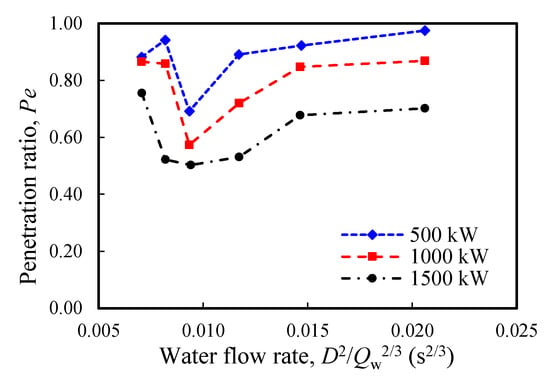
Figure 14.
Penetration ratio vs. water flow rates under 6.1 m ceiling [72].
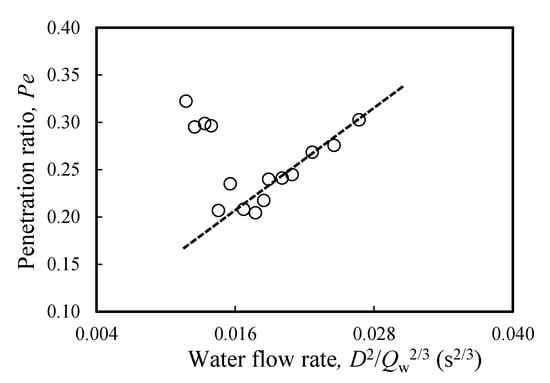
Figure 15.
Penetration ratio (Pe) vs. water flow rates [72].
Nam [73] investigated sprinkler penetration capabilities with multiple factors by conducting steady-state simulations, which suggested that an optimal flow rate exists from any given ceiling height to provide the highest penetration ratio in a practical flow range. It is expected that an increase in flow rate will result in great suppression performance, as the flow rate is linked to the operating pressure, which has been shown to improve suppression. These results highlight the importance of designing water mist suppression systems with appropriate flow rates. Water quantity contributes to flame cooling, which has been established as one of the extinguishing mechanisms of water mist. The relationship between nozzle operating pressure and the discharge flow rate of a water mist nozzle can be described by the K-factor of the nozzle [5,12,40,74,75].
4.1.5. Effect of Different Nozzle K-Factors
The K-factor of a spray nozzle is defined as the discharge coefficient. It relates to the amount of water permitted through the nozzle at a given pressure. Equation (4) is used to determine the nozzle pressure from the set K-factor in relation to the flow rate [76].
where P is the pressure at the inlet of the nozzle (bar), Q is the nozzle flow rate (L/min), and k is the discharge coefficient K-factor .
It has been previously found that the leading suppression mechanism of a water mist system is the O2 displacement that comes from a smaller droplet size, achieved with a higher operating nozzle pressure. Equation (4) shows that the pressure and discharge coefficient are inversely proportional; the spray momentum provides a K-factor for any given nozzle, highlighting the importance of nozzle selection when designing a water mist system.
4.1.6. Effect of Different Spray Momentum
The spray momentum relates to the mass, velocity, and spray direction relative to the fire [73]. The suppression system’s ability to penetrate the fire plume with water mist droplets depends on the spray momentum. Additionally, it determines the entrainment rate of the surrounding air into the fire plume. High momentum effectively cools the flame and fuels and causes faster steam generation, which results in oxygen displacement, whereas low momentum can achieve water droplet suspension in the fire compartment, contributing to radiation attenuation [40]. Due to the water vapour mist in the combustion zone, the spray mass is a combination of both the mass of the liquid-phase water and the mass of the vapour-phase water and air entrained by water mist. Lui and Kim [6] developed an equation for spray momentum, which can be expressed in Equation (5).
where is the spray momentum; is the mass of the liquid-phase water; is the mass of the vapour-phase water; is the mass of the air entrained by the mist; and is the velocity vector of the water mist.
Nam [73], Santangelo and Tartarini [77], Pokorný et al. [78], and Sikanen et al. [79] have focused their research on water mist spray momentum. Experiments show that water mist spray momentum varies depending on the distance from the spray nozzle, as the accumulated mass is shown to reduce as distance increases, as shown in Figure 16. These findings agree with Nam’s [73] earlier research showing that the spray momentum also decreases further away from the spray nozzle, as shown in Figure 17. It was also found (as shown in Figure 18) that, most of the time, water mist’s ability to penetrate the flame increases as the spray momentum increases. The water mist’s ability to penetrate the flame helps the water cool the flame and extract heat. Heat extraction has been shown to be one of the main suppression mechanisms of water mist and explains why spray momentum is a key design parameter in ensuring the system can penetrate the flame and aid heat extraction. For all three cases (500 kW, 1000 kW, 1500 kW), the penetration ratio clearly increases when the spray momentum ratio is increased. The spray momentum and flame penetration are directly affected by the spray angle of the discharge nozzle [20].
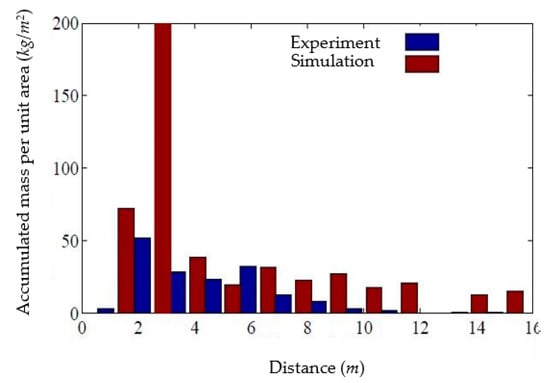
Figure 16.
Accumulated mass relative to distance from the nozzle in a large-scale hall experiment [79].
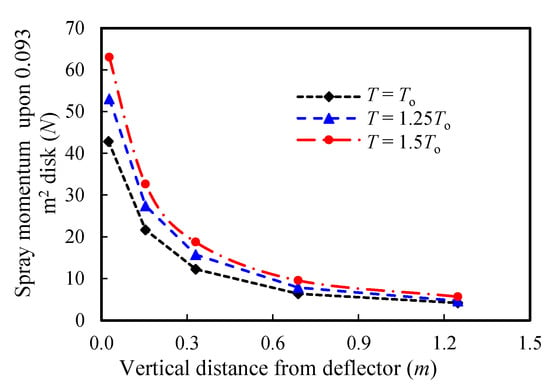
Figure 17.
Spray momentum effect at 4.42 L/s [73].
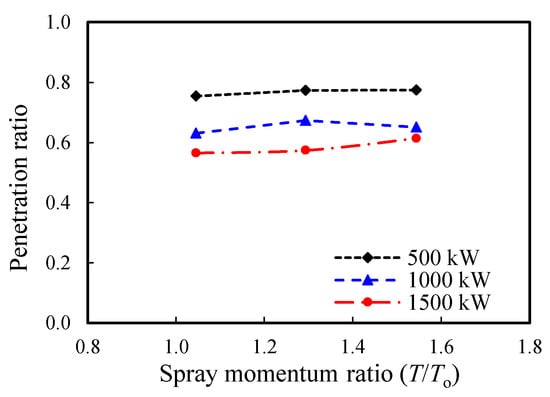
Figure 18.
Spray moment effect at 3.161 L/s [73].
4.1.7. Effect of Different Spray Angles
The spray angle of a nozzle (θ) is measured from the central axis of the nozzle, as shown in Figure 19, and is important to water mist system performance. Studies focused on the effect of different spray angles have determined that a small nozzle spray angle provides a faster extinguishment time, as shown in Figure 20, in experiments completed at three different angles [20].
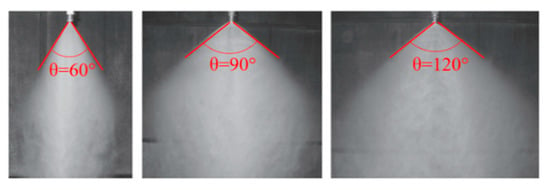
Figure 19.
Nozzle spray angles for fire testing [20].
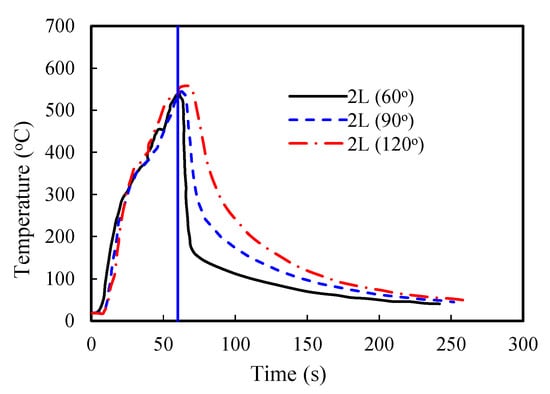
Figure 20.
Time vs. temperature for different water mist nozzle spray angles [20].
It can be observed that the smaller spray angle performs better because the buoyancy of the hot smoke layer is reduced and suppressed by the injection of water mist within a very short time [7]. Without the direct injection from the smaller spray angle, the water is unable to effectively penetrate the buoyant hot layer, explaining why the large spray angle is less effective. To overcome this, it has been suggested that when the spray angle is increased, the flow rate needs to be adjusted simultaneously to maintain suppression performance [20]. Given what can be understood from the reviewed literature, this inability to effectively penetrate the buoyant hot layer with a large spray angle would also be expected if a nozzle’s proximity to the flame were extended by increasing the nozzle height and other compartment variables.
4.2. Fire Compartments
Water mist suppression performance is not only affected by the design parameters of the system but also by the arrangement of the fire compartment it is installed in. The system’s ability to cool the flame and fuel surfaces, displace the oxygen in the room, and maintain radiation attenuation depends heavily on the compartment’s ceiling height, enclosure size and ventilation, and the dynamic mixing of gases, which are discussed in the following subsections.
4.2.1. Effect of Different Ceiling Heights
The literature available on the effects of different ceiling and nozzle heights shows that water mist is able to control fires, though its performance decreased with an increase in ceiling height [12,67,75]. It has been suggested that this performance reduction is due to the water mist penetration capabilities being reduced, which cannot sufficiently counter the fire plume. Testing has shown that deluge-type water mist is effective up to a height of 9.1 m and with a closed head system of only 6.1 m [67]. The testing of nozzles located close to the fuel source resulted in cooling contributing to the reduction in flame size, and the spray from the water mist was able to block the movement of the fuel between the fire sources [75]. An increase in ceiling height introduces an increase in the enclosure volume, which has been shown to alter suppression performance [80]. Since sprinkler systems have similar properties, early research on sprinkler systems completed by Nam [73] also suggested that penetration capabilities are reduced as the ceiling height increases. This research shows how ceiling height is an important factor in water mist fire suppression performance and why it is an important design parameter that must be considered.
4.2.2. Effect of Different Enclosure Volumes and Ventilation
Enclosure volume effects on water mist suppression are similar to ceiling height. It is understood that the increase in a fire compartment’s volume reduces the effectiveness of water mist in fire suppression [7,80,81], though there is little effort or research dedicated to finding ways of overcoming this. The testing completed by Bill et al. [8,12] showed that water mist was unable to suppress certain fire designs when there were no boundary walls, regardless of the number of nozzles added to the system. The maximum size of the compartment in which the system could extinguish fire was 940 m3. Figure 21 shows the test results when the fire was extinguished.
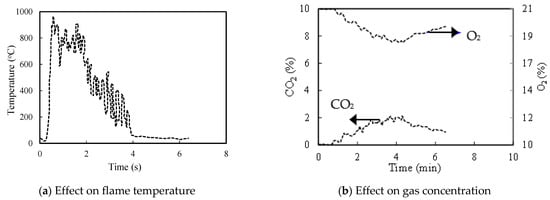
Figure 21.
Effect of water mist on a 6 MW diesel-spray fire inside a 940 m3 compartment [12].
The O2 concentration reached a low of only 18.5% at the time of extinguishment, indicating that the main suppression mechanism contributing to the fire extinguishment was the cooling effect, not the oxygen displacement. This was confirmed in subsequent tests [8,12], when the fire was shielded from the cooling effect of the water, and extinguishment could not be achieved with only the displacement of oxygen. An enclosed compartment with minimum ventilation allows for a continuous reduction in oxygen, resulting in the timely extinguishment of fires even if they are shielded from the water spray. Inside an enclosed compartment, hot gases from the fire accumulate near the ceiling, and when water mist is discharged downwards into the hot gases, maximum water vaporisation is achieved. This also pushes the combustion products down towards the floor, which is known as dynamic mixing.
4.2.3. Effect of Different Dynamic Mixing Situations
The dynamic mixing of gases in a fire compartment due to water mist discharge aids fire suppression through the reduction in the oxygen concentration in the lower portion of the compartment. It also increases the convective mixing of mist, water vapour, and combustion gases near the fire, resulting in the enhancement of the mist’s extinguishing capacity [82]. Studies have shown that suppression is less effective when nozzles are located lower within the compartment, below the hot layer of gases [34,83]. Nozzles closer to the ceiling have the ability to push and mix the gases back down into the combustion zone. Knowledge of dynamic mixing has led to the concept of cycling discharge, where water mist is cycled on and off to achieve a faster extinguishment time in some cases. Combustion gases rise to the top of the compartment quickly when mist is cycled off and then are mixed back into the compartment when cycled on. This force continues the dynamic mixing of water vapour and combustion gases near the fire [57]. Figure 22a,b, from fire tests conducted by Lui et al. [57], shows that discharge cycling reduced extinguishment time, which was attributed to the higher depletion and dilution rate of oxygen caused by dynamic mixing. As previously discussed, the dilution of oxygen is one of the leading mechanisms in fire extinguishment from a water mist system. This research shows that dynamic mixing created from discharge cycling may significantly improve the performance of a water mist system. This could be applied to existing water mist products available for use.
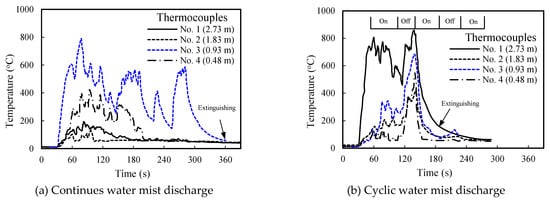
Figure 22.
Temperature over a round-pan fire with different water mist discharge rates [57].
4.2.4. Effect of External Environment and wind conditions
In the external environment, ambient conditions such as local wind may influence the dispersal and effectiveness of misting systems. Studies of bushfire–wind interactions arising from “modelled” bushfire events provide a basis for the consideration of droplet size and, hence, the effectiveness of misting systems for external conditions [84]. These investigations found that turbulent winds can be enhanced by the effects of a fire event, increasing pulsating wind speeds. These conditions dictate that roof-mounted nozzles will be less effective than those nozzles placed closer to the ground and can be blown onto the surfaces of critical building elements. Existing standards for bushfire spray systems [85,86], whilst providing a starting point, do not address the limitations of nozzle location and design in the development of bushfire protection systems. The volume of water storage, usage, and application are crucial when considering enhanced bushfire protection, potentially giving misting systems an advantage over traditional drenching systems.
4.3. Current Products for Water Mist Systems
A number of water mist systems available on the market have been reviewed to understand their designed applications, limitations, and operating parameters. Water mist systems can be categorised by their operating pressure as either low-pressure (<12.1 bar), intermediate-pressure (12.1 to 34.5 bar), or high-pressure (>34.5 bar) [8]. The key parameters of the existing water mist products on the market are summarised in Table 3 and compared with the parameters found in previous research. Most of the existing water mist products have either low operating pressure or high operating pressure, which are discussed in the below subsections. The purpose of this section is to highlight the limitations of different water mist systems available on the market. This is important for future research that could lead to the improvement of these systems or the development of new types for different applications.

Table 3.
Summary of various water mist parameters from existing research and available products.
4.3.1. Low-Pressure and Intermate-Pressure Systems
Tyco AquaMist ULF
The AquaMist Ultra Low Flow (ULF) is marketed as a low-pressure water mist system and total flooding system. It is designed to operate at working pressures of 7 to 16 bar and to produce droplets of 100 to 200 µm in diameter [21]. This water mist system has various configurations and available nozzle types for different applications and can either be installed with a pumped water supply or with stored water and pressure cylinders, as shown in Figure 23a,b. It is UL- and FM Global-listed for applications in machinery spaces and on machinery components, oil cookers, and combustion or steam turbines. Depending on the nozzles used, the system’s application is restricted at various ceiling heights, the largest possible height being 10 m. Tyco also offers a high-pressure water mist system.
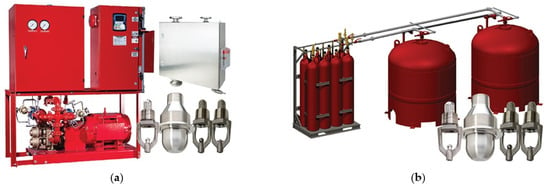
Figure 23.
Typical components of an AquaMist ULF’s pumped water supply and stored pressure configuration. (a) ULF pumped water supply configuration [91]; (b) AquaMist ULF stored pressure system [21].
VID FireKill APS Atrium System
FireKill has designed a product for use in atriums and other large rooms [89]. The open nozzle system is designed to operate with a pressure of 10 bar and to be discharged horizontally from the wall. A droplet size of less than 300 µm is discharged from either side of the fire compartment, as shown in Figure 24. This system differs from many others due to the fact that there is no limit on the ceiling height of the atrium, though its listing is still limited by the width of the walls at up to 26 m.
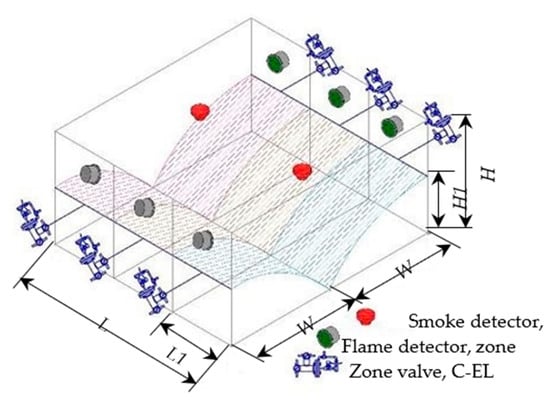
Figure 24.
VID FireKill APS Atrium System general arrangement schematic [89].
4.3.2. High-Pressure Systems
Tyco AquaMist FOG
The AquaMist FOG is a high-pressure water mist system that operates at 50 to 200 bar to produce droplets of an approximate diameter of 50 µm [21,92]. This water mist system also has multiple nozzle types suitable for each application and can be either pumped or used with stored pressure cylinders, as shown in Figure 25. This water mist system is FM Global-listed for use in machinery and combustion turbine enclosures, and it is restricted to a volume not exceeding 260 m3 and a maximum ceiling height of 5 m. This system is similar to Kidde’s high-pressure Marioff HI-FOG system.
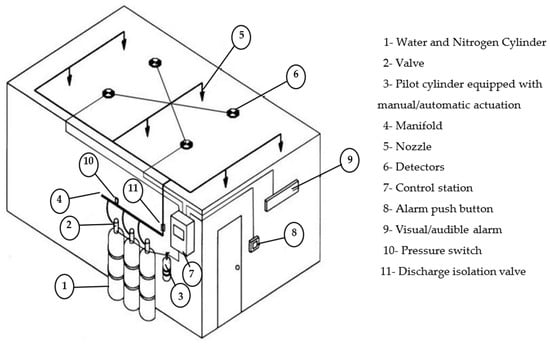
Figure 25.
Typical components of an AquaMist FOG stored pressure general arrangement [92].
Marioff HI-FOG
Marioff HI-FOG is a high-pressure water mist system designed for total compartment protection, with a minimum operating pressure of 40 bar, and to produce water droplets of approximately 50 µm [90,93]. This water mist system is FM Global-listed for use on combustion turbines, machinery paces, and special hazard machinery spaces. Figure 26 shows the layout of this water system for turbine enclosure protection.
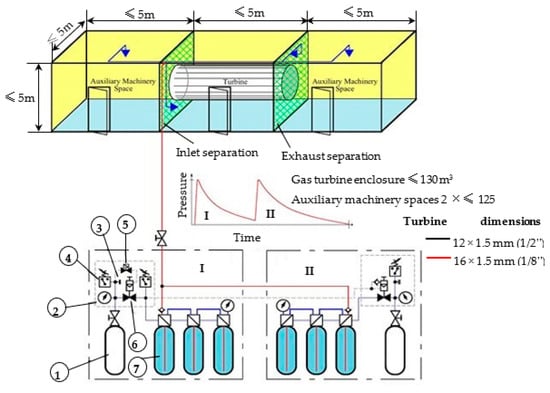
Figure 26.
Marifoff HI-FOG installation example for a turbine enclosure [93].
Danfoss SEM-SAFE System
The SEM-SAFE system is a high-pressure water mist system designed to operate at approximately 100 bar of pressure and produce water droplets ranging from 10 to 50 µm in diameter [47]. The general arrangement of this water mist system is shown in Figure 27. FM approval allows this water mist system to be used in datacentres, machinery spaces, corridors, and offices with 5 m high ceilings or less. This water mist system is also suggested for offshore applications.
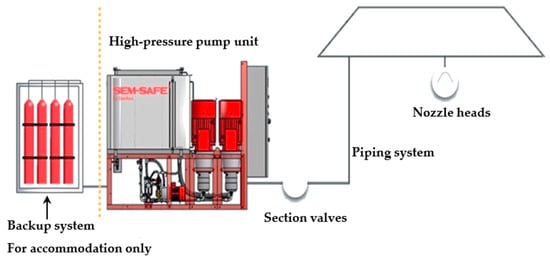
Figure 27.
SEM-SAFE water mist system main components [47].
5. Design Codes for Water Mist Systems
Water mist is typically designed under a performance-based approach, as it is not one-size-fits-all. There are some standards that govern the design, installation, and maintenance of water mist fire suppression systems. The relevant codes and standards will depend on the authority with jurisdiction applicable to the geographical location of the system. The main standards currently available for water mist suppression designs are National Fire Protection Association Standard NFPA 750 [8], Australian Standard AS 4587 [94], British Standard BS 8458 [50], and European Standard EN 14972 [95]. In addition, AS5414 [85] has been developed for bushfire water spray systems. The objective of these standards is to provide users of water mist fire protection systems with minimum design, installation, testing, and commissioning requirements. The design sections of the standards direct the users to follow the system’s listed requirements. This lack of information and guidelines in the standards can be interpreted as stemming from research gaps related to water mist fire suppression systems. The basic design criteria of the NFPA 750 [8] and AS 4587 [94] water mist design codes are summarised in Table 4. These two standards both specify similar requirements for components such as pipework and fitting material, corrosion protection, the use of strainers, pipe supports, and the use of isolation and check valves, all of which focus on the maintenance and durability of the system to extend the operational life.

Table 4.
Water mist design code comparison.
5.1. American Standards
The NFPA Technical Committee on Water Mist Fire Suppression Systems was organised in 1993 by research and engineering communities, water mist system manufacturers, the insurance industry, and enforcement authorities [8]. The NFPA 750 standard was issued and is regularly updated to contain the minimum requirements for the design, installation, maintenance, and testing of water mist protection systems. This standard lists the specific applications of water mist for machinery spaces, combustion turbines, processing equipment, local applications, industrial oil cookers, computer rooms, chemical fume hoods, and continuous wood board presses. The standard includes occupancy protection systems for residential building applications. This standard does not provide definitive fire performance criteria, nor does it offer specific guidance on system design to specifically control, suppress, or extinguish fire [8].
5.2. Australian Standards
The Standards Australia Committee FP-011 for Special Hazard Fire Protection Systems issued their first standard for water mist fire protection systems in 1999 [94]. The AS 4587 standard [94] covers the minimum requirements and recommendations for the design, installation, and commissioning of water mist fire protection systems and describes the characteristics of the various types of systems. It lists the specific applications of water mist for machinery spaces, combustion turbines, industrial oil cookers, and local pool and spray fire applications. The standard does not include residential occupancies or other building applications. The standard does not provide a performance criterion on an application rate or density basis [94]. The standard does not cover water mist systems in residential occupancies or explosion suppression.
AS5414 [85] was developed for ember protection under bushfire conditions and does not adequately address radiant heat exposure or provide design parameters for higher bushfire attack exposures on the critical elements of buildings; rather, it addresses the overall coverage of water with nozzle spacing and locations (including roof ridges).
5.3. British Standards
The British Standards Institution published the BS 8458 standard for fixed fire protection systems for residential and domestic water mist systems in 2015 [50]. The BS 8458 standard covers the design, installation, water supply, commissioning, maintenance, and testing of water mist systems with automatic nozzles installed in both domestic and residential occupancies [50]. This standard does not cover water mist systems used in industrial and commercial buildings. Industrial and commercial water mist systems are covered by BS 8489-1 [96] and BS 8489-7 [55].
5.4. European Standard
The European Committee for Standardization published the European standard for fixed water mist firefighting systems. The EN 14972 standard specifies the requirements and provides recommendations for the design, installation, inspection, and maintenance of all types of fixed, land-based water mist systems [95]. The scope does not cover explosion protection or use within vehicles.
5.5. Test protocols
Water mist systems are performance-based, and they are designed and tested against established fire test protocols that are acceptable to the relevant authority with jurisdiction. Fire test protocols are designed by testing authorities to match or simulate a specific hazard through established performance criteria. Table 5 includes formalised fire test protocols produced by approval agencies that are widely accepted globally [25].

Table 5.
Fire test protocol for water mist fire protection systems [25].
6. Challenges and Issues
The current progress in water mist fire suppression technology and industry use has been established by reviewing the methods of generating water mist suppression; the suppression mechanisms, applications, and key performance parameters; and the applicable design standards. The existing research has shown the current challenges and issues associated with using water mist as a fire suppression solution. The main challenges and issues that were observed based on the literature review are discussed in the below subsections.
6.1. Operation and Maintenance
The main challenge of water mist fire suppression systems is the methods of generating small water droplets using high-pressure discharge and small nozzle orifices, which contributes to technical concerns [29]. These factors combined create the potential for plugging and blockages caused by corrosive products inside the pipework. The alternative for small droplet sizes to be maintained is using a lower pressure when using twin-fluid systems, except that the dual supply lines and storage of water and compressed gas significantly increase the operation and maintenance cost of the water mist fire suppression system [7]. Systems could require more frequent maintenance than other fire suppression systems and the design of the system could require more effort to suit the environment within which it will be installed. It has been noted in current research that there are several maintenance and inspection questions that need to be examined, such as how often should piping be flushed, strainers be cleaned or changed, and pumps be tested [64]. Unfortunately, long-term maintenance history data are largely unknown or unproven for water mist systems [54]. The literature recommends utilizing existing automatic water sprinkler maintenance guidelines for water mist systems. More appropriate guidelines should be written specifically for individual types of water mist systems, as they vary depending on the application. This should be written by the manufacturers or the authority with jurisdiction in the form of a legislated standard.
6.2. Design and Standardisation
It has been established that the physical phenomenon of fire suppression by water mist is complex. Extensive research has shown that there are a lot of factors contributing to the suppression of fire, including water droplet size [9,19,29,52,56,60,61,62], spray momentum [73], nozzle angle [5,25,94], nozzle height [5,9,65], compartment size [6,9], ventilation [6,9], burning fuel load [18,57,95], and the spray nozzle activation method [97,98]. The varying effects of these parameters make it difficult to design a water mist suppression system by applying first principles. There is currently no theoretical basis for considering all these parameters in the design process, and a standardised approach to system design is yet to be fully developed. Designers must apply a performance-based approach if the application does not fall under an approved solution. When completing a performance-based solution, the complexities of water mist fire suppression systems are difficult to model accurately using computational fire dynamic simulation software due to the low amount of research data available to extract input parameters to model accurate water mist fire suppression scenarios. For a performance-based assessment to be verified and supported, fire testing will sometimes be required to validate the model. Design parameters are normally established from large-scale fire test data on a case-by-case basis for specific applications. This method of design can make a water mist system less cost-effective, which restricts the expansion of water mist fire suppression applications.
6.3. Application Challenges
Though water mist has proven to be an effective fire suppression solution for a variety of fire scenarios, its use is restricted in many locations around the world to industrial applications by product listings, and it cannot be used in commercial or residential buildings. We found that water mist is becoming more commonplace for residential use in areas that follow the NFPA and British Standards. Before it is accepted in Australia and other parts of the world, an increase in performance data and historical evidence of its ability to control fires need to be established [99,100]. This will provide engineers and approval authorities with jurisdiction with the ability to assess if a water mist system is a suitable fire protection solution for the specific application. When considering the approval of water mist systems for residential or commercial applications regarding life safety, the information available is limited [99,100]. To avoid the complex design requirements of large-scale fire testing to prove water mist works in specific applications, it is only used in applications where test data have already been established, such as machinery spaces, turbine enclosures, marine accommodation spaces, and industrial cookers. There is potential for water mist to suit other applications such as light-hazard occupancies, electronic environments, storage facilities, and residential and commercial buildings, as well as bushfire protection [86]. More efforts in developing test protocols for these applications are required.
6.4. Economic Challenges
The economic issues resulting from complex design and system components have been mentioned in different studies [4,44,77]. There are multiple methods of generating water mist, though they each come with expenses that can make water mist a costly option [77] when compared with alternative suppression methods, such as standard sprinklers or gaseous systems [44]. As long as gaseous agents are available, affordable, and permitted for use, water mist may remain an expensive option for asset protection. Further research can be performed to minimise the total cost of water mist fire suppression systems.
7. Conclusions and Recommendations
This literature review analysed previous research and industry data to summarise the suppression mechanisms, applications, products, design standards, test protocols and limitations of water mist fire suppression systems. The ability of water mist systems to suppress and control a fire by cooling, displacing oxygen, and attenuating radiation has made it an effective fire suppression solution for many applications, although there are some limitations. Various products have been designed for specific applications, typically in industrial and marine environments. Challenges and issues still exist around using water mist in new and emerging fire risk applications. It is recommended that further research be conducted that focuses on the performance of water mist in various fire scenarios to better understand and improve water mist systems to make it a suitable and cost-effective fire protection solution in building and industrial applications. The following suggestions can be considered to enhance the potential use of water mist fire suppression systems in building and industrial applications.
- (a)
- Further research can be conducted to develop corrosion-resistant materials and other methods of reducing the potential to block small orifice nozzles.
- (b)
- More research on the performance of water mist suppression at various nozzle heights, fire compartment configurations, and various fuel types and fire scenarios can be conducted.
- (c)
- A theoretical basis can be developed for the design process that can be applied to a wide range of hazards and can be used for a prescriptive design and installation standard.
- (d)
- New test protocols should be developed and tested for water mist in light-hazard occupancies and residential building spaces as an alternative to fire sprinklers.
- (e)
- Environmental benefits associated with water mist can be investigated for an alternative to gaseous suppression systems across the life cycle of products.
- (f)
- Research should be conducted to look at the potential water mist may have in assisting in fire protection in new and emerging fire hazards that the industry is trying to adapt to, such as bushfire protection, combustible cladding, electric battery storage facilities, electric cars, automated warehouse facilities, switchboards, datacentres, and compact residential buildings.
Author Contributions
Conceptualization, M.K.H. and K.F.; Formal analysis, K.F., M.K.H. and M.D.H.; Investigation, K.F.; Methodology, M.K.H., M.D.H. and K.F.; Resources, M.K.H. and S.S.; Supervision, M.K.H. and S.S.; Visualization, M.K.H. and M.D.H.; Writing—original draft, K.F., M.D.H. and M.K.H.; Writing—review and editing, P.R., G.D., S.S. and B.A. All authors have read and agreed to the published version of the manuscript.
Funding
This research received no external funding.
Acknowledgments
The authors would like to thank Western Sydney University for providing access to academic literature and standards.
Conflicts of Interest
There are no conflict of interest.
Nomenclature:
| µm | Micrometre or micron | Critical radiation intensity required for piloted ignition | |
| O2 | Oxygen | Heat vaporisation of water | |
| K | Kelvin | Pressure inlet at nozzle | |
| Flame extinguishing temperature | Q | Nozzle flow rate | |
| Theoretical flame temperature | k | Discharge coefficient K-factor | |
| Surface temperature of fuel | Spray momentum | ||
| Mass fraction of oxygen | Mass of liquid-phase water | ||
| Mass fraction of fuel vapour | Mass of vapour-phase water | ||
| r | Stoichiometric ratio | Mass of air entrained by mist | |
| Heat removed per unit area | Velocity vector of water mist | ||
| Convective heat transfer per unit area | °C | Degree Celsius | |
| Heat required to produce a unit mass of vapour | kg | Kilograms | |
| Burning rate per unit area | kJ | Kilojoules | |
| Heat transfer to the fuel surface | H2O | Dihydrogen monoxide | |
| Heat lost from the surface | C2H2 | Acetylene | |
| Minimum water flow rate | CH2 | Methylene | |
| Fuel surface area | CO | Carbon monoxide | |
| Emissivity of the radiator | m | Meter | |
| Stefan–Boltzmann constant | CO2 | Carbon dioxide | |
| View factor of the fuel load | |||
| Mean absolute temperature of radiation source | |||
| Mean absolute temperature of the surface | |||
| Abbreviations: | |||
| ULF | Ultra-low flow | ||
| FM | Factory Mutual | ||
| HRR | Heat release rate | ||
| NFPA | National Fire Protection Association | ||
| AS | Australian Standard | ||
| FDS | Fire Dynamics Simulator | ||
| LOC | Limiting oxygen concentration | ||
| PMMA | Polymethyl methacrylate | ||
| Lpm | Litres per minute | ||
| MC | Multi-component | ||
References
- Cui, Y.; Liu, J. Research progress of water mist fire extinguishing technology and its application in battery fires. Process Saf. Environ. Prot. 2021, 149, 559–574. [Google Scholar] [CrossRef]
- Adiga, K.; Hatcher, R.F., Jr.; Sheinson, R.S.; Williams, F.W.; Ayers, S. A computational and experimental study of ultra fine water mist as a total flooding agent. Fire Saf. J. 2007, 42, 150–160. [Google Scholar] [CrossRef]
- Mahmud, H. Simulation of the Suppression of Fires Using Water Mists. Ph.D. Thesis, Victoria University, Melbourne, VIC, Australia, 2016. [Google Scholar]
- Yazir, D. Application of IF-TOPSIS method on fixed fire fighting systems for cargo hold fires on the dry/bulk cargo ships. Ocean Eng. 2022, 260, 111891. [Google Scholar] [CrossRef]
- Ko, Y.J.; Elsagan, N.; Gibbs, E. Water Mist Systems for Protection of Mass Timber Structures—Phase 2 Residential Fire Suppression Tests; National Research Council Canada: Ottawa, ON, Canada, 2020. [Google Scholar]
- Liu, Z.; Kim, A.K. A review of water mist fire suppression systems—Fundamental studies. J. Fire Prot. Eng. 1999, 10, 32–50. [Google Scholar]
- Liu, J.; Liao, G.; Li, P.; Fan, W.; Lu, Q. Progress in research and application of water mist fire suppression technology. Chin. Sci. Bull. 2003, 48, 718–725. [Google Scholar] [CrossRef]
- NFPA 750; Standard on Water Mist Fire Protection Systems. 2022.
- Mawhinney, J.R.; Back, G.G. Water mist fire suppression systems. In SFPE Handbook of Fire Protection Engineering; Springer: New York, NY, USA, 2016; pp. 1587–1645. [Google Scholar]
- Chang, W.Y.; Fu, P.K.; Chen, C.H.; Shu, Y.L. Performance evaluation of a water mist system in semiconductor wet bench fires. Process Saf. Environ. Prot. 2008, 86, 213–218. [Google Scholar] [CrossRef]
- Nmira, F.; Consalvi, J.L.; Kaiss, A.; Fernandez-Pello, A.; Porterie, B. A numerical study of water mist mitigation of tunnel fires. Fire Saf. J. 2009, 44, 198–211. [Google Scholar] [CrossRef]
- Bill, R., Jr.; Hansen, R.L.; Richards, K. Fine-spray (water mist) protection of shipboard engine rooms. Fire Saf. J. 1997, 29, 317–336. [Google Scholar] [CrossRef]
- Lee, J. Numerical analysis on the rapid fire suppression using a water mist nozzle in a fire compartment with a door opening. Nucl. Eng. Technol. 2019, 51, 410–423. [Google Scholar] [CrossRef]
- Log, T.; Cannon-Brookes, P. Water mist for fire protection of historic buildings and museums. Mus. Manag. Curatorship 1995, 14, 283–298. [Google Scholar]
- Sturm, P.; Pucher, K.; Rodler, J.; Mühlenbruch, G.; Krezschmar, P. Test of Water Mist Equipment to increase Escape Chances in Cases of Fire in Tunnels. In Proceedings of the International Water Mist Association Conference, Vienna, Austria, 4–6 April 2001. [Google Scholar]
- Lee, J. Numerical analysis of how ventilation conditions impact compartment fire suppression by water mist. Ann. Nucl. Energy 2020, 136, 107021. [Google Scholar] [CrossRef]
- Cao, X.Y.; Bi, M.S.; Ren, J.S.; Chen, B. Experimental research on explosion suppression affected by ultrafine water mist containing different additives. J. Hazard. Mater. 2019, 368, 613–620. [Google Scholar] [CrossRef] [PubMed]
- Cong, B.; Liao, G. Experimental studies on water mist suppression of liquid fires with and without additives. J. Fire Sci. 2009, 27, 101–123. [Google Scholar] [CrossRef]
- Ferng, Y.M.; Liu, C.H. Numerically investigating fire suppression mechanisms for the water mist with various droplet sizes through FDS code. Nucl. Eng. Des. 2011, 241, 3142–3148. [Google Scholar] [CrossRef]
- Yinshui, L.; Zhuo, J.; Dan, W.; Xiaohui, L. Experimental research on the water mist fire suppression performance in an enclosed space by changing the characteristics of nozzles. Exp. Therm. Fluid Sci. 2014, 52, 174–181. [Google Scholar] [CrossRef]
- TycoAquaMist. Tyco Fire Protection Products. Available online: https://tycoaquamist.com/uploads/media/AquaMist_Machinery_Space_EMEA_0317_LoRes.pdf (accessed on 3 January 2023).
- Drysdale, D. An Introduction to Fire Dynamics; John Wiley & Sons: New York, NY, USA, 2011. [Google Scholar]
- Yang, D.; Converse, M.C.; Mahvi, D.M.; Webster, J.G. Expanding the bioheat equation to include tissue internal water evaporation during heating. IEEE Trans. Biomed. Eng. 2007, 54, 1382–1388. [Google Scholar] [CrossRef]
- Drysdale, D. Ignition of liquids. In SFPE Handbook of Fire Protection Engineerings; Springer: New York, NY, USA, 2016; pp. 554–580. [Google Scholar]
- Hurley, M.J.; Gottuk, D.T.; Hall, J.R., Jr.; Harada, K.; Kuligowski, E.D.; Puchovsky, M.; Watts, J.M., Jr.; Wieczorek, C.J. SFPE Handbook of Fire Protection Engineering; Springer: New York, NY, USA, 2015. [Google Scholar]
- Majdalani, A.H.; Carvel, R. Effectiveness of the Gas Cooling Technique in Larger Compartment Fires; Final Report; 2016. [Google Scholar]
- Xin, Y.; Khan, M.M. Flammability of combustible materials in reduced oxygen environment. Fire Saf. J. 2007, 42, 536–547. [Google Scholar] [CrossRef]
- Mawhinney, J. Water mist fire suppression systems for marine applications: A case study. In The TRIS and ITRD Database; Institute of Marine Engineers IMAS 94: Hong Kong, 1994. [Google Scholar]
- Liu, H.; Wang, C.; Cordeiro, I.M.D.C.; Yuen, A.C.Y.; Chen, Q.; Chan, Q.N.; Kook, S.; Yeoh, G.H. Critical assessment on operating water droplet sizes for fire sprinkler and water mist systems. J. Build. Eng. 2020, 28, 100999. [Google Scholar] [CrossRef]
- Kashiwagi, T.; Ohlemiller, T.J. A study of oxygen effects on nonflaming transient gasification of PMMA and PE during thermal irradiation. In Symposium (International) on Combustion; Elsevier: Amsterdam, The Netherlands, 1982; pp. 815–823. [Google Scholar]
- Balner, D.; Barcova, K. Attenuation of thermal radiation through water mist. Process Saf. Prog. 2018, 37, 18–24. [Google Scholar] [CrossRef]
- Choi, B.-I.; Han, Y.-S.; Oh, C.-B.; Kim, M.-B.; Kim, C. The assessment of fire suppression capability of water-mist system for machinery engine room. Fire Sci. Eng. 2007, 21, 111–117. [Google Scholar]
- Liu, Z.; Kim, A.; Su, J. Improvement of efficacy of water mist in fire suppression by cycling discharges. In Proceedings of the Second International Conference on Fire Research and Engineering, Gaithersburg, MD, USA, 10–15 August 1997; pp. 3–8. [Google Scholar]
- Liu, Z.; Kim, A.; Su, J. The effect of air convection on the performance of water mist fire suppression systems. Asme-Publ.-Htd 1998, 357, 227–236. [Google Scholar]
- Yudong, F.; Jianghong, L.; Guangxuan, L.; Qiang, X.; Xiaomeng, Z. Experimental studies on electrical breakdown field strength of electrode with water mist containing MC additives. Chin. Sci. Bull. 2005, 50, 2783–2788. [Google Scholar] [CrossRef]
- Lu, J.; Chen, B.-H.; Fang, Z.; Hu, J.; Wang, B.; Wu, C.; Huang, S. Electrical safety of suppressing wildfires near high-voltage transmission lines using water mist. J. Fire Sci. 2018, 36, 295–314. [Google Scholar] [CrossRef]
- Hills, A.T.; Simpson, T.; Smith, D.P. Water mist fire protection systems for telecommunication switch gear and other electronic facilities. In Proceedings of the Water Mist Fire Suppression Workshop, Gaithersburg, MD, USA, 1–2 March 1993; pp. 123–144. [Google Scholar]
- Liu, Z.; Kim, A.K. A review of water mist fire suppression technology: Part II—Application studies. J. Fire Prot. Eng. 2001, 11, 16–42. [Google Scholar] [CrossRef]
- Zhou, Y.; Bu, R.; Gong, J.; Zhang, X.; Fan, C.; Wang, X. Assessment of a clean and efficient fire-extinguishing technique: Continuous and cycling discharge water mist system. J. Clean. Prod. 2018, 182, 682–693. [Google Scholar] [CrossRef]
- Arvidson, M. Large-scale water spray and water mist fire suppression system tests for the protection of Ro–Ro cargo decks on ships. Fire Technol. 2014, 50, 589–610. [Google Scholar] [CrossRef]
- Marker, T.R.; Sarkos, C.P.; Hill, R.G. Water Spray System Development and Evaluation for Enhanced Postcrash Fire Survivability and In-Flight Protection in Cargo Compartments. In Federal Aviation Administration, Aircraft Fire Safety; 1997; Volume 1997, pp. 1–3. [Google Scholar]
- Sarkos, C.P. Development of improved fire safety standards adopted by the Federal Aviation Administration. In Agard, Aircraft Fire Safety 14 (See N 90-17581 10-03); 1989. [Google Scholar]
- Mawhinney, J.R. Approval Testing of a Hi-Fog Water Mist System for Protection of the A86 Passenger Vehicle Highway Tunnel; Marioff Corporation Oy: Bern, Switzerland, 2005. [Google Scholar]
- Ha, G.; Shin, W.G.; Lee, J. Numerical analysis to determine fire suppression time for multiple water mist nozzles in a large fire test compartment. Nucl. Eng. Technol. 2021, 53, 1157–1166. [Google Scholar] [CrossRef]
- Liu, Z.; Carpenter, D.; Kim, A.K. Characteristics of large cooking oil pool fires and their extinguishment by water mist. J. Loss Prev. Process Ind. 2006, 19, 516–526. [Google Scholar] [CrossRef]
- Qin, J.; Yao, B.; Chow, W.K. Experimental study of suppressing cooking oil fire with water mist using a cone calorimeter. Int. J. Hosp. Manag. 2004, 23, 545–556. [Google Scholar] [CrossRef]
- Systems S-SFS. SEM-SAFE by Danfoss High-Pressure Water Mist Fire Fighting System. 2022. Available online: https://www.danfoss.com/en/about-danfoss/our-businesses/fire-safety/ (accessed on 3 January 2023).
- Xu, J.; Duan, Q.; Zhang, L.; Liu, Y.; Sun, J.; Wang, Q. The enhanced cooling effect of water mist with additives on inhibiting lithium ion battery thermal runaway. J. Loss Prev. Process Ind. 2022, 77, 104784. [Google Scholar] [CrossRef]
- Jenft, A.; Collin, A.; Boulet, P.; Pianet, G.; Breton, A.; Muller, A. Experimental and numerical study of pool fire suppression using water mist. Fire Saf. J. 2014, 67, 1–12. [Google Scholar] [CrossRef]
- British Standards BS 8458:2015: Fixed Fire Protection Systems—Residential and Domestic Water Mist Systems—Code of Practice for Design and Installation. NBS Database: 2015.
- Milke, J.; Gerschefski, C. Overview of Water Research for Library Applications. In Proceedings of the International Conference on Fire Research and Engineering, Orlando, FL, USA, 10–15 September 1995; p. 133. [Google Scholar]
- Wang, Z.; Wang, X.; Huang, Y.; Tao, C.; Zhang, H. Experimental study on fire smoke control using water mist curtain in channel. J. Hazard. Mater. 2018, 342, 231–241. [Google Scholar] [CrossRef] [PubMed]
- Budnick, E. USFA Residential Water Mist Test Program (Initial Feasibility); National Institute of Standards and Technology: Gaithersburg, MD, USA, 1996. [Google Scholar]
- Arvidson, M. An evaluation of residential sprinklers and water mist nozzles in a residential area fire scenario, Research Institutions of Sweden. RISE Rep. 2017, 4, 2017. [Google Scholar]
- British Standards BS 8489-7 2016: Fixed Fire Protection Systems—Industrial and Commercial Watermist Systems-Part: Fire performance tests and requirements for watermist systems for the protection of low hazard occupancies, British Standards Institution.
- Huang, X.; Wang, X.; Liao, G. Characterization of an effervescent atomization water mist nozzle and its fire suppression tests. Proc. Combust. Inst. 2011, 33, 2573–2579. [Google Scholar] [CrossRef]
- Liu, Z.; Kim, A.K.; Su, J.Z. Examination of the extinguishment performance of a water mist system using continuous and cycling discharges. Fire Technol. 1999, 35, 336–361. [Google Scholar] [CrossRef]
- Qin, J.; Weng, W. Preliminary study of water mist suppressing ghee flame in historical building in the northwest China. J. Cult. Herit. 2006, 7, 329–333. [Google Scholar] [CrossRef]
- Xiaomeng, Z.; Biao, Z.; Xiang, J. Study of fire-extinguishing performance of portable water-mist fire extinguisher in historical buildings. J. Cult. Herit. 2010, 11, 392–397. [Google Scholar] [CrossRef]
- Prasad, K.; Patnaik, G.; Kailasanath, K. A numerical study of water-mist suppression of large scale compartment fires. Fire Saf. J. 2002, 37, 569–589. [Google Scholar] [CrossRef]
- Mahmud, H.I.; Moinuddin, K.A.; Thorpe, G.R. Experimental and numerical study of high-pressure water-mist nozzle sprays. Fire Saf. J. 2016, 81, 109–117. [Google Scholar] [CrossRef]
- Jeong, C.S.; Lee, C.Y. Experimental investigation on spray characteristics of twin-fluid nozzle for water mist and its heptane pool fire extinguishing performance. Process Saf. Environ. Prot. 2021, 148, 724–736. [Google Scholar] [CrossRef]
- Zhang, P.; Tang, X.; Tian, X.; Liu, C.; Zhong, M. Experimental study on the interaction between fire and water mist in long and narrow spaces. Appl. Therm. Eng. 2016, 94, 706–714. [Google Scholar] [CrossRef]
- Zalosh, R. Water Mist for Deflagration Control. In Water Mist for Deflagration Control; National Fire Protection Association: Quincy, MA, USA, 1994. [Google Scholar]
- Shrigondekar, H.; Chowdhury, A.; Prabhu, S. Characterization of a simplex water mist nozzle and its performance in extinguishing liquid pool fire. Exp. Therm. Fluid Sci. 2018, 93, 441–455. [Google Scholar] [CrossRef]
- Yu, H.Z. The ceiling height limits for water mist protection of two solid combustible fire hazards in open environment. Fire Technol. 2021, 57, 163–187. [Google Scholar] [CrossRef]
- Chow, W.K.; Yao, B. The potential application of water mist systems for fire protection in atria. ASHRAE Trans. 2001, 107, 171. [Google Scholar]
- Moore, T.A.; Weitz, C.; McCormick, S.; Clauson, M. Laboratory Optimization and Mediumscale Screening of Iodide Salts and Water Mixtures. In Proceedings of Halon Option Technical Working Conference, Albuquerque, NM, USA, 7–9 May 1996; pp. 477–498. [Google Scholar]
- DeSipio, P. Evaluation of Fine Water Mist for Aircraft Dry Bay Fire Suppression. 1996. p. 27. Available online: https://www.nist.gov/system/files/documents/el/fire_research/R0301051.pdf (accessed on 10 July 2022).
- Finnerty, A.E. Water-Based Fire-Extinguishing Agents. 1995. p. 461. Available online: https://www.nist.gov/system/files/documents/el/fire_research/R0000244.pdf (accessed on 15 August 2022).
- Yu, H.-Z.; Kasiski, R.; Daelhousen, M. Characterization of twin-fluid (water mist and inert gas) fire extinguishing systems by testing and modeling. Fire Technol. 2015, 51, 923–950. [Google Scholar] [CrossRef]
- Pei, B.; Li, J.; Wang, Y.; Wen, X.; Yu, M.; Jing, G. Synergistic inhibition effect on methane/air explosions by N2-twin-fluid water mist containing sodium chloride additive. Fuel 2019, 253, 361–368. [Google Scholar] [CrossRef]
- Nam, S. Numerical simulation of the penetration capability of sprinkler sprays. Fire Saf. J. 1999, 32, 307–329. [Google Scholar] [CrossRef]
- Yu, H.-Z.; Zhou, X.; Carpenter, J. Physical scaling of water mist fire extinguishment in industrial machinery enclosures. Fire Saf. J. 2017, 91, 596–605. [Google Scholar] [CrossRef]
- Pepi, J.S. Advances in the technology of intermediate pressure water mist systems for the protection of flammable liquid hazards. In Proceedings of the Halon Options Technical Working Conference, Albuquerque, NM, USA, 12–14 May 1998. [Google Scholar]
- Tanner, G.; Knasiak, K.F. Spray characterization of typical fire suppression nozzles. In Proceedings of the Third International Water Mist Conference, Madrid, Spain, 22–24 September 2003. [Google Scholar]
- Santangelo, P.E.; Tartarini, P. Fire control and suppression by water-mist systems. Open Thermodyn. J. 2010, 4, 167–184. [Google Scholar] [CrossRef]
- Pokorný, M.; Eliáš, M.; Kregl, F. Fire Protection of Steel Structures by Low Pressure Water Mist in Large-Scale Fire Test. In Conference Series: Earth Environmental Science; IOP Publishing: Bristol, UK, 2019; p. 012028. [Google Scholar]
- Sikanen, T.; Vaari, J.; Hostikka, S. Large scale simulation of high pressure water mist systems. WIT Trans. Eng. Sci. 2013, 79, 77–88. [Google Scholar]
- Vaari, J. A transient one-zone computer model for total flooding water mist fire suppression in ventilated enclosures. Fire Saf. J. 2002, 37, 229–257. [Google Scholar] [CrossRef]
- Kim, S.C.; Ryou, H.S. An experimental and numerical study on fire suppression using a water mist in an enclosure. Build. Environ. 2003, 38, 1309–1316. [Google Scholar] [CrossRef]
- Lui, Z.; Kim, A. A Review of water mist fire suppression technology. Part II—Fundamental Studies. J. Fire Prot. Eng. 2001, 10, 16–42. [Google Scholar]
- Hansen, R.; Back, G. Fine Water Mist–Fire Control Using Local Application. In Proceedings of the 1997 International CFC and Halon Alternative Conference, Washington, DC, USA; 1997. [Google Scholar]
- He, Y.; Kwok, K.; Douglas, G.; Razali, I. Numerical Investigation of Bushfire-Wind Interactions and its Impacts on Building Structure. Fire Saf. Sci. 2011, 11, 1449–1462. [Google Scholar] [CrossRef]
- Australian Standard AS5414-2012: Bushfire Water Spray Systems. SAI Global. Accessed 6 November 2020.
- Green, A. Sprinkler Systems for Protection of Buildings from Wildfire. Ph.D. Thesis, Wollongong University, Hong Kong, 2019. [Google Scholar]
- Yang, P.; Liu, T.; Qin, X. Experimental and numerical study on water mist suppression system on room fire. Build. Environ. 2010, 45, 2309–2316. [Google Scholar] [CrossRef]
- Vaari, J.; Hostikka, S.; Sikanen, T.; Paajanen, A. Numerical simulations on the performance of water-based fire suppression systems. VTT Technol. 2012, 54, 150. [Google Scholar]
- FireKill. Atrium Fire Protection System Model APS VID FireKill. Available online: https://vidfirekill.dk/solutions/solutions/] (accessed on 15 June 2022).
- Maioff Hi-FOG Water Mist System. Available online: https://www.suppression.com/uploads/pdf/suppression-kidde-hifog/accumulator-units/mau/ls01551.pdf (accessed on 15 June 2022).
- AquaMist. AquaMist Mist Control Center (MCC) Pump Skin Unit, DATASHEET TFP2270.1 OCTOBER 2021. Available online: https://tycoaquamist.com/uploads/media/TFP2270.1_10_2021_v2_.pdf (accessed on 15 August 2022).
- Fire, L. Installation, Maintenance and User Manual for Water Mist Cylinder Bank Systems; 2009. [Google Scholar]
- Luciano Nigro. Performance Based Fire Protection With Water Mist. Available online: https://iwma.net/fileadmin/user_upload/Seminar_Dubai_2013/Marioff_Nigro_Dubai_2013.pdf (accessed on 15 August 2022).
- Australian Standard. AS 4587:2020: Water Mist Fire Protection Systems—System Design, Installation, and Commissioning. SAI Global Database, 2020.
- European Standards EN 14972-1:2020: Fixed Fire-Fighting Systems—Water Mist Systems—Part 1: Design, Installation, Inspection and Maintenance. European Standards EN 14972-1:2020; CEN: Oak Brook, IL, USA, 2020.
- British Standards BS 8489-1 2016: Fixed Fire Protection Systems. Industrial and Commercial Water Mist Systems—Code of Practice for Design and Installation.
- Hopkin, C.; Spearpoint, M.; Muhammad, Y.; Makant, W. Estimating the suppression performance of an electronically controlled residential water mist system from BS 8458: 2015 fire test data. Fire 2022, 5, 144. [Google Scholar] [CrossRef]
- Spearpoint, M.; Hopkin, C.; Muhammad, Y.; Makant, W. Replicating the activation time of electronically controlled water mist system nozzles in B-RISK. Fire Saf. J. 2022, 130, 103592. [Google Scholar] [CrossRef]
- Frank, K.; Gravestock, N.; Spearpoint, M.; Fleischmann, C. A review of sprinkler system effectiveness studies. Fire Sci. Rev. 2013, 2, 6. [Google Scholar] [CrossRef]
- Gravestock, N. Effectiveness of Fire Safety Systems for Use in Quantitative Risk Assessments; New Zealand Fire Service Commission: Wellington, New Zealand, 2008. [Google Scholar]
Disclaimer/Publisher’s Note: The statements, opinions and data contained in all publications are solely those of the individual author(s) and contributor(s) and not of MDPI and/or the editor(s). MDPI and/or the editor(s) disclaim responsibility for any injury to people or property resulting from any ideas, methods, instructions or products referred to in the content. |
© 2023 by the authors. Licensee MDPI, Basel, Switzerland. This article is an open access article distributed under the terms and conditions of the Creative Commons Attribution (CC BY) license (https://creativecommons.org/licenses/by/4.0/).